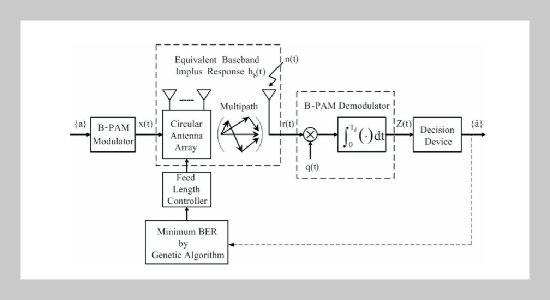REFERENCES
- [1] Federal Communications Commission, “Revision of Part 15 of the Commission’s Rules Regarding UltraWideband Transmission System, FIRST REPORT AND ORDER,” FCC, ET Docket, pp. 1�118 (2002).
- [2] Colak, S., Wong, T. F. and Serbest, A. H., “UWB Dipole Array with Equally Spaced Elements of Different Lengths,” 2007 IEEE International Conference on Ultra-Wideband, pp. 789�793 (2007).
- [3] Malik, W. Q., Edwards, D. J. and Stevens, C. J., “Angular-Spectral Antenna Effects in Ultra-Wideband Communications Links,” IEE Proc.-Commun., Vol. 153 (2006).
- [4] Funk, E. E. and Lee, C. H., “Free-Space Power Combining and Beam Steering of Ultra-Wideband Radiation Using an Array of Laser-Triggered Antennas,” IEEE Trans. Microwave Theory Tech., Vol. 44, pp. 2039�2044 (1996).
- [5] Yazdandoost, K. Y. and Kohno, R., “Free-Space Power Combining and Beam Steering of Ultra-Wideband Radiation Using an Array of Laser-Triggered Antennas,” IEEE Communication Magazine, Vol. 42, pp. 29�32 (2004).
- [6] Ghavami, M., “Wideband Smart Antenna Theory Using Rectangular Array Structures,” IEEE Trans. Signal Processing, Vol. 50, pp. 2143�2151 (2002).
- [7] Tarokh, V., Seshadri, N. and Calderbank, A. R., “Space-Time Codes for High Data Rate Wireless Communications: Performance Criterion and Code Construction,” IEEE Trans. Inform. Theory, Vol. 44, pp. 744�745 (1998).
- [8] Chen, C. H. and Chiu, C. C., “Novel Optimum Radiation Pattern by Genetic Algorithms in Indoor Wireless Local Loop,” IST Mobile Summit 2000, Galway, Ireland (2000). (Proc., pp. 391�399).
- [9] Peng, M. and Wang, W., “Comparison of Capacity between Adaptive Tracking and Switched Beam Smart Antenna Techniques in TDD-CDMA Systems,” Microwave, Antenna, Propagation and EMC Technologies for Wireless Communications, 2005, Vol. 1, pp. 135�139 (2005).
- [10] Ares, F. J., Rodriguez, A., Villanueva, E. and Rengarajan, S. R., “Genetic Algorithms in the Design and Optimization of Antenna Array Patterns,” IEEE Trans. Antennas and Propagat., Vol. 47, pp. 506�510 (1999).
- [11] Gueguen, E., Thudor, F. and Chambelin, P., “A Low Cost UWB Printed Dipole Antenna with High Performance,” IEEE International Conference on UltraWideband, pp. 89�92 (2005).
- [12] Talom, F. T., Uguen, B., Rudant, L., Keignart, J., Pintos, J.-F. and Chambelin, P., “Evaluation and Characterization of an UWB Antenna in Time and Frequency Domains,” IEEE International Conference on UltraWideband, pp. 669�673 (2006).
- [13] Manteuffel, D., “Radio Link Characterization Using Real Antenna Integration Scenarios for UWB Consumer Electronic Applications,” Ultra Wideband Systems, Technologies and Applications, 2006. The Institution of Engineering and Technology Seminar, pp. 123�130 (2006).
- [14] El-Hadidy, M. and Kaiser, T., “Impact of Ultra WideBand Antennas on Communications in a Spatial Cannel,” 1st International Cognitive Radio Oriented Wireless Networks and Communications, 2006, pp. 1�5 (2006).
- [15] Liu, C. L., Ho, M. H., Chiu, C. C. and Cheng, C. Y., “A Comparison of UWB Communication Characteristics for Various Corridors,” ACTA International Journal of Modelling and Simulation, Vol. 30, pp. 172�177 (2010).
- [16] Ho, M. H., Liao, S. H. and Chiu, C. C., “A Novel Smart UWB Antenna Array Design by PSO,” Progress in Electromagnetic Research C, Vol. 15. pp. 103�115, (2010).
- [17] Ho, M. H., Liao, S. H. and Chiu, C. C., “UWB Communication Characteristics for Different Distribution of People and Various Materials of Walls,” Tamkang Journal of Science and Engineering, Vol. 13, pp. 315� 326 (2010).
- [18] Liao, S. H., Ho, M. H. and Chiu, C. C., “Bit Error Rate Reduction for Multiusers by Smart UWB Antenna Array,” Progress In Electromagnetic Research C, Vol. 16. pp. 85�98 (2010).
- [19] Liao, S. H., Chiu, C. C., Ho, M. H. and Liu, C. L., “Channel Capacity of Multiple-Input Multiple-Output Ultra Wide Band Systems with Single Co-Channel Interference,” International Journal of Communication Systems, Vol. 23, pp. 1600�1612 (2010).
- [20] Liao, S. H., Chen, H. P., Chiu, C. C. and Liu, C. L. “Channel Capacities of Indoor MIMO-UWB Transmission for Different Material Partitions,” Tamkang Journal of Science and Engineering, Vol. 14, pp. 49� 63 (2011).
- [21] Chiu, C. C., Kao, Y. T., Liao, S. H. and Huang, Y. F., “’UWB Communication Characteristics for Different Materials and Shapes of the Stairs,” Journal of Communications, Vol. 6, pp. 628�632 (2011).
- [22] Liao, S. H., Ho, M. H., Chiu, C. C. and Lin, C. H. “Optimal Relay Antenna Location in Indoor Environment Using Particle Swarm Optimizer and Genetic Algorithm,” Wireless Personal Communications, Vol. 62, pp. 599�615 (2012).
- [23] Ho, M. H., Chiu, C. C. and Liao, S. H., “Bit Error Rate Reduction for Circular UWB Antenna by DDE,” International Journal of RF and Microwave ComputerAided Engineering, Vol. 22, pp. 260�271 (2012).
- [24] Malik, W. Q., Edwards, D. J., Zhang, Y. and Brown, A. K., “Three-Dimensional Equalization of Ultrawideband Antenna Distortion,” in Proc. Int. Conf. Electromagn. Adv. Apps. (ICEAA), Torino, Italy (2007).
- [25] Yao, R., Chen, Z. and Guo, Z., “An Efficient Multipath Channel Model for UWB Home Networking,” Radio and Wireless Conference, 2004 IEEE, pp. 511�516 (2004).
- [26] Oppermann, I., Hamalainen, M. and Iinatti, J., UWB Theory and Applications, John Wiley & Sons (2004).
- [27] Homier, E. A. and Scholtz, R. A., “Rapid Acquisition of Ultra-Wideband Signals in the Dense Multi-Path Channel,” IEEE Conference on Ultra Wideband Systems and Technologies, pp. 105�109 (2002).
- [28] Gargin, D. J., “A Fast and Reliable Acquisition Scheme for Detecting Ultra Wide-Band Impulse Radio Signals in the Presence of Multi-Path and Multiple Access Interference,” 2004 International Workshop on Ultra Wideband Systems, pp. 106�110 (2004).
- [29] Liu, C. L., Chiu, C. C., Liao, S. H. and Chen, Y. S., “Impact of Metallic Furniture on UWB Channel Statistical Characteristics,” Tamkang Journal of Science and Engineering, Vol. 12, pp. 271�278 (2009).
- [30] Goldberg, D. E., Genetic Algorithm in Search, Optimization and Machine Learning. Addison Wesley (1989).
- [31] Johnson, J. M. and Rahmat-Samii, Y., “Genetic Algorithms in Engineering Electromagnetics,” IEEE Antennas and Propagation Magazine, Vol. 39, pp. 7�21, (1997).









